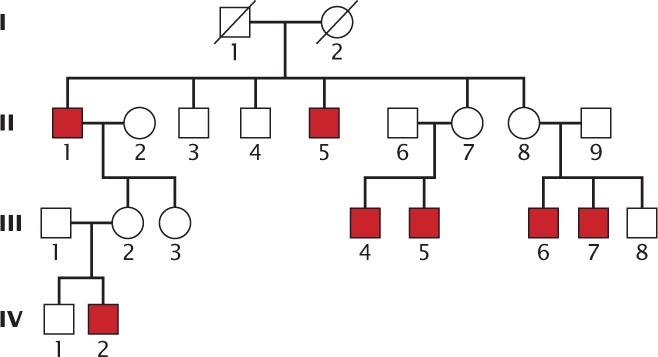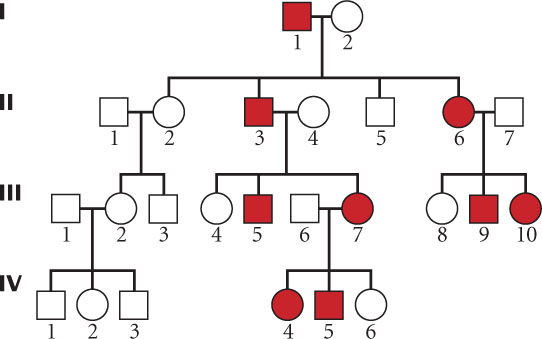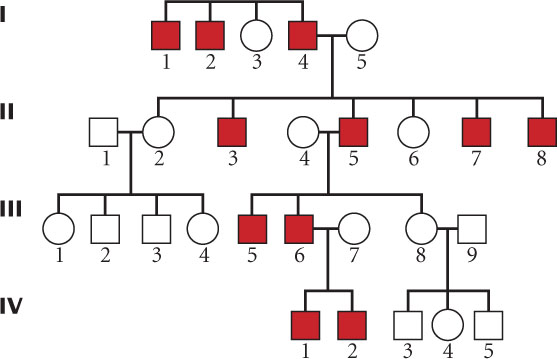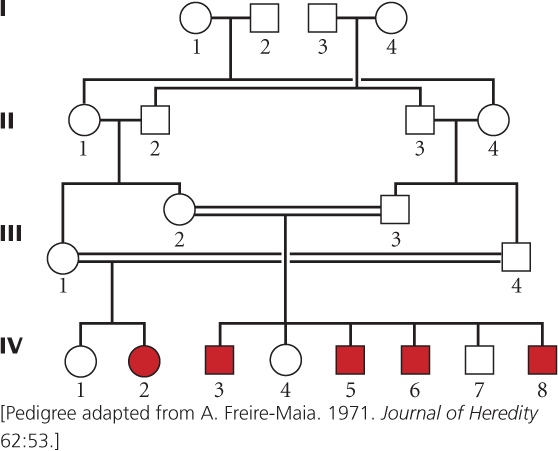Application Questions and Problems
Section 6.1
Question 6.18
If humans have characteristics that make them unsuitable for genetic analysis, such as long generation time, small family size, and uncontrolled crosses, why do geneticists study humans? Give several reasons why humans have been the focus of so much genetic study.
Section 6.2
Question 6.19
Joe is color blind. Both his mother and his father have normal vision, but his mother’s father (Joe’s maternal grandfather) is color blind. All Joe’s other grandparents have normal color vision. Joe has three sisters—Patty, Betsy, and Lora—all with normal color vision. Joe’s oldest sister, Patty, is married to a man with normal color vision; they have two children, a 9-year-old color-blind boy and a 4-year-old girl with normal color vision.
- a. Using standard symbols and labels, draw a pedigree of Joe’s family.
- b. What is the most likely mode of inheritance for color blindness in Joe’s family?
- c. If Joe marries a woman who has no family history of color blindness, what is the probability that their first child will be a color-blind boy?
- d. If Joe marries a woman who is a carrier of the color-blind allele, what is the probability that their first child will be a color-blind boy?
- e. If Patty and her husband have another child, what is the probability that the child will be a color-blind boy?
Question 6.20
Consider the pedigree shown in Figure 6.3.
- a. If individual IV-7 married a person who was unaffected with Waardenburg syndrome, what is the probability that their first child would have Waardenburg syndrome? Explain your reasoning.
- b. If individuals IV-4 and IV-5 mated and produced a child, what is the probability that the child would have Waardenburg syndrome? Explain your reasoning.
Question 6.21
 Many studies have suggested a strong genetic predisposition to migraine headaches, but the mode of inheritance is not clear. L. Russo and colleagues examined migraine headaches in several families, two of which are shown below (L. Russo et al. 2005. American Journal of Human Genetics 76:327–333). What is the most likely mode of inheritance for migraine headaches in these families? Explain your reasoning.
Many studies have suggested a strong genetic predisposition to migraine headaches, but the mode of inheritance is not clear. L. Russo and colleagues examined migraine headaches in several families, two of which are shown below (L. Russo et al. 2005. American Journal of Human Genetics 76:327–333). What is the most likely mode of inheritance for migraine headaches in these families? Explain your reasoning.

Question 6.22
 Dent disease is a rare disorder of the kidney, in which reabsorption of filtered solutes is impaired and there is progressive renal failure. R. R. Hoopes and colleagues studied mutations associated with Dent disease in the following family (R. R. Hoopes et al. 2005. American Journal of Human Genetics 76:260–267).
Dent disease is a rare disorder of the kidney, in which reabsorption of filtered solutes is impaired and there is progressive renal failure. R. R. Hoopes and colleagues studied mutations associated with Dent disease in the following family (R. R. Hoopes et al. 2005. American Journal of Human Genetics 76:260–267).

- a. On the basis of this pedigree, what is the most likely mode of inheritance for the disease? Explain your reasoning.
- b. From your answer to part a, give the most likely genotypes for all persons in the pedigree.
Question 6.23
A man with a specific unusual genetic trait marries an unaffected woman and they have four children. Pedigrees of this family are shown in parts a through e, but the presence or absence of the trait in the children is not indicated. For each type of inheritance, indicate how many children of each sex are expected to express the trait by filling in the appropriate circles and squares. Assume that the trait is rare and fully penetrant.
- a. Autosomal recessive trait

- b. Autosomal dominant trait

- c. X-linked recessive trait

- d. X-linked dominant trait

- e. Y-linked trait

Question 6.24
For each of the following pedigrees, give the most likely mode of inheritance, assuming that the trait is rare. Carefully explain your reasoning.
- a.

- b.

- c.

- d.

- e.

Question 6.25
The trait represented in the following pedigree is expressed only in the males of the family. Is the trait Y linked? Why or why not? If you believe that the trait is not Y linked, propose an alternate explanation for its inheritance.

Question 6.26
 The following pedigree illustrates the inheritance of Nance–Horan syndrome, a rare genetic condition in which affected persons have cataracts and abnormally shaped teeth.
The following pedigree illustrates the inheritance of Nance–Horan syndrome, a rare genetic condition in which affected persons have cataracts and abnormally shaped teeth.

- a. On the basis of this pedigree, what do you think is the most likely mode of inheritance for Nance–Horan syndrome?
- b. If couple III-7 and III-8 have another child, what is the probability that the child will have Nance–Horan syndrome?
- c. If III-2 and III-7 were to mate, what is the probability that one of their children would have Nance–Horan syndrome?
Question 6.27
 The following pedigree illustrates the inheritance of ringed hair, a condition in which each hair is differentiated into light and dark zones. What mode or modes of inheritance are possible for the ringed-hair trait in this family?
The following pedigree illustrates the inheritance of ringed hair, a condition in which each hair is differentiated into light and dark zones. What mode or modes of inheritance are possible for the ringed-hair trait in this family?

Question 6.28
 Ectrodactyly is a rare condition in which the fingers are absent and the hand is split. This condition is usually inherited as an autosomal dominant trait. Ademar Freire-Maia reported the appearance of ectrodactyly in a family in São Paulo, Brazil, whose pedigree is shown here. Is this pedigree consistent with autosomal dominant inheritance? If not, what mode of inheritance is most likely? Explain your reasoning.
Ectrodactyly is a rare condition in which the fingers are absent and the hand is split. This condition is usually inherited as an autosomal dominant trait. Ademar Freire-Maia reported the appearance of ectrodactyly in a family in São Paulo, Brazil, whose pedigree is shown here. Is this pedigree consistent with autosomal dominant inheritance? If not, what mode of inheritance is most likely? Explain your reasoning.

Question 6.29
 The complete absence of one or more teeth (tooth agenesis) is a common trait in humans—indeed, more than 20% of humans lack one or more of their third molars. However, more-severe absence of teeth, defined as missing six or more teeth, is less common and frequently an inherited condition. L. Lammi and colleagues examined tooth agenesis in the Finnish family shown in the pedigree below (L. Lammi. 2004. American Journal of Human Genetics 74:1043–1050).
The complete absence of one or more teeth (tooth agenesis) is a common trait in humans—indeed, more than 20% of humans lack one or more of their third molars. However, more-severe absence of teeth, defined as missing six or more teeth, is less common and frequently an inherited condition. L. Lammi and colleagues examined tooth agenesis in the Finnish family shown in the pedigree below (L. Lammi. 2004. American Journal of Human Genetics 74:1043–1050).

- a. What is the most likely mode of inheritance for tooth agenesis in this family? Explain your reasoning.
- b. Are the two sets of twins in this family monozygotic or dizygotic twins? What is the basis of your answer?
- c. If IV-2 married a man who has a full set of teeth, what is the probability that their child would have tooth agenesis?
- d. If III-2 and III-7 married and had a child, what is the probability that their child would have tooth agenesis?
Section 6.3
Question 6.30
A geneticist studies a series of characteristics in monozygotic twins and dizygotic twins, obtaining the concordances listed below. For each characteristic, indicate whether the rates of concordance suggest genetic influences, environmental influences, or both. Explain your reasoning.
| Concordance(%) | ||
|---|---|---|
| Characteristic | Monozygotic | Dizygotic |
| Migraine headaches | 60 | 30 |
| Eye color | 100 | 40 |
| Measles | 90 | 90 |
| Clubfoot | 30 | 10 |
| High blood pressure | 70 | 40 |
| Handedness | 70 | 70 |
| Tuberculosis | 5 | 5 |
Question 6.31
On the basis of the concordance rates shown in Table 6.2, is variation in rheumatoid arthritis influenced by genetic factors, environmental factors, or both? Explain your reasoning.
Question 6.32
 M. T. Tsuang and colleagues studied drug dependence in male twin pairs (M. T. Tsuang et al. 1996. American Journal of Medical Genetics 67:473–477). They found that 82 out of 313 monozygotic twins were concordant for abuse of one or more elicit drugs, whereas 40 out of 243 dizygotic twins were concordant for the same trait. Calculate the concordance rates for drug abuse in these monozygotic and dizygotic twins. On the basis of these data, what conclusion can you make concerning the roles of genetic and environmental factors in drug abuse?
M. T. Tsuang and colleagues studied drug dependence in male twin pairs (M. T. Tsuang et al. 1996. American Journal of Medical Genetics 67:473–477). They found that 82 out of 313 monozygotic twins were concordant for abuse of one or more elicit drugs, whereas 40 out of 243 dizygotic twins were concordant for the same trait. Calculate the concordance rates for drug abuse in these monozygotic and dizygotic twins. On the basis of these data, what conclusion can you make concerning the roles of genetic and environmental factors in drug abuse?
Question 6.33
 In a study of schizophrenia (a mental disorder including disorganization of thought and withdrawal from reality), researchers looked at the prevalence of the disorder in the biological and adoptive parents of people who were adopted as children; they found the following results:
In a study of schizophrenia (a mental disorder including disorganization of thought and withdrawal from reality), researchers looked at the prevalence of the disorder in the biological and adoptive parents of people who were adopted as children; they found the following results:
| Prevalence of schizophrenia | ||
|---|---|---|
| Adopted Persons | Biological parents | Adoptive parents |
| With schizophrenia | 12 | 2 |
| Without schizophrenia | 6 | 4 |
[Source: S. S. Kety et al. 1978. in The Nature of Schizophrenia: New Approaches to Research and Treatment, L. C. Wynne, R. L. Cromwell, and S. Matthysse, Eds. New York: Wiley, 1978, pp. 25–37.]
What can you conclude from these results concerning the role of genetics in schizophrenia? Explain your reasoning.
Question 6.34
Which conclusions are supported by Figure 6.13?
- a. Adoptive fathers of obese children have a higher BMI than adoptive fathers of thin children.
- b. Adoptive mothers of thin children have lower BMI than adoptive mothers of obese children.
- c. Biological fathers of obese children have higher BMI than adoptive fathers of thin children.
- d. Both a and b.
- e. Both a and c.
Section 6.4
Question 6.35
What, if any, ethical issues might arise from the widespread use of noninvasive prenatal genetic diagnosis, which can be carried out much earlier than amniocentesis or chorionic villus sampling?